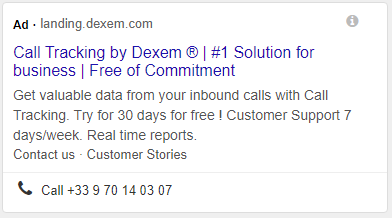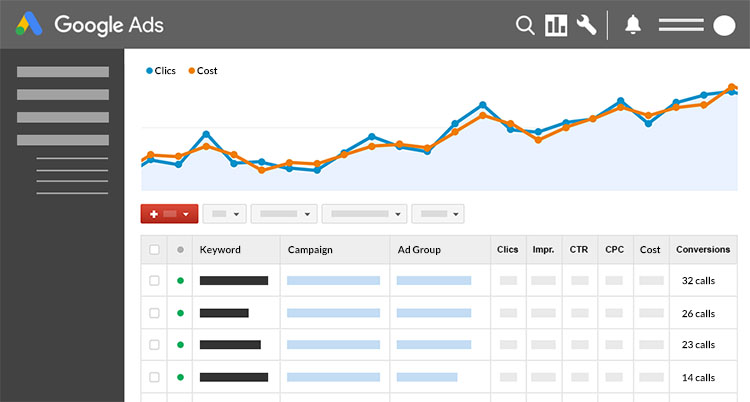Thanks to your Google AdWords (or Google Ads) Search campaigns, you can track clics, filled forms or online sales. And you can also receive phone calls from your visitors who have either clicked on a web extension in your ad, or who clicked on your ad and then called from your webpages.
With a Call Tracking tool, you know where your phone conversions are coming from, and you can easily associate them with an AdWords campaign, ad, or even keyword. Here, we tell you everything about why tracking your inbound calls from AdWords can bring you a lot, and show you how to implement the tool to get complete and accurate conversions reports.
AdWords inbound calls : How to calculate your actual CPL
Every year, online advertising investments are getting bigger for businesses, and so does the gap between online ads and other medias. According to the French E-advertising Observatory, online advertising in France stands for 4.9 million euros in 2018, and 40% of these are dedicated to Seach ads.
Let’s remind that Google as a search engine owns more than 90% of market shares in France. Then it seems pretty logical that Google AdWords also leads the Search advertising market.
So, many French companies of all size and from all sectors invest in AdWords campaigns daily to increase lead generation.
And if AdWords campaigns are not carefully managed, they can quickly become expensive with no profit. To make sure they have a good ROI from AdWords, marketers need to track some specific metrics.
One of these metrics is cost per lead (CPL). Meaning is: which is the average acquisition cost of a group of ads, one single ad, or even a keyword on AdWords? With this data, you can easily measure how your campaigns are performing, and then better adjust and optimize your AdWords budgets.
To calculate your CPL, you must take in account all the leads your business generates, including phone leads.
Call Tracking is a complementary tool you need to identify phone conversions as coming from Google AdWords, and then to measure the actual cost per lead of your seach campaigns.
As an example, let’s take these 2 ads:
- Ad A has generated 10 completed online forms for a product demo, and it cost the company 1000€ in a month time. Then, the cost per lead is 100€ for this ad.
- Ad B has generated 20 online forms for the same 1000€, still during one month.
As it is twice more leads than for ad A, the cost per lead is only 50€ for this ad.
Conclusion: Ad B performed better during this month and showed a higher ROI.
However, with Call Tracking in your toolbox, phone leads are also taken in account to complete this data. Let’s suppose ad A has generated 20 phone calls to the company, when ad B has generated only 5.
- Ad A has actually generated 30 leads, and its cost per lead is then 33€.
- Ad B has generated 25 leads in total, and its cost per lead is 40€.
Thanks to Call Tracking, your analysis is more accurate with some additional and relevant data to manage your AdWords campaigns.
And here you will see how you can set it to track your phone conversions from Google AdWords.
Analyzing inbound calls from AdWords ad extensions
With Google AdWords, you can improve your Search ads by adding extensions, namely call extensions. These allow you to display your phone number in your ads. On mobile, they become a click-to-call button so it is easier for users to call you.
Desktop ad with call extension
Mobile ad with call extension
In your AdWords account, you can track the clics on your call extensions. But here, this metric shows call intents, and not how many calls you actually received.
Just give it a try: on mobile, when touching a click-to-call button, the call is not immediately processed, first it will open your dial pad pre-filled with the phone number. So some clicks on a call extension might not end up with an actual call.
A Call Tracking tool measures only the real calls received by companies from AdWords extensions. This is what the “Phone Calls” metric stands for.
In easy words, you can set a tracking number as a call extension in Google AdWords. And then, people calling this number will be redirected straight to the announcer’s phone number.
Depending on how detailed analysis you are looking for, one tracking number can be used on a campaign, ad group, single ad or even a keyword level.
Call Tracking allows you to easily quantify inbound calls on these tracking numbers, and then directly measure the number of calls generated by your Seach ads.
This data completes your CPL and makes you’re A/B testing and AdWords campaigns optimization more accurate and clearer.
Tracking inbound calls of website visitors coming from AdWords
In most cases, users click on an online ad before converting and calling your company. Then, your phone leads can be browsing a landing page or a page of your website when you first see them.
With a Call Tracking tool, you can analyze exactly that incoming calls from your website are made by visitors who first found you on AdWords. Even better, you can get detailed session-based information about the origin of your calls: which ads your visitors viewed, which of your pages they visited, which keywords they entered, …
Identifying phone conversions originated from AdWords traffic source
Call Tracking has a feature called Dynamic Number Insertion. This feature allows you to replace dynamically a phone number on a website with a tracking number assigned to a traffic source. This is what we call dynamic Call Tracking by traffic source.
The tech is easily run with a simple JavaScript tag you put on your website, directly in the HTML code or through a tag tool such as Google Tag Manager.
Concretely, with DNI implemented on your pages, all the visitors who came on your site via an AdWords campaign see the same tracking number displayed.
And all the calls you receive from this tracking number are identified as coming from the traffic source AdWords.
So in addition with calls from your ads’ call extensions, you know exactly how many calls you received in total from Google AdWords.
Analyzing web sessions of callers from AdWords
There is another possible usage of Dynamic Number Insertion: indeed, one specific tracking number can be assigned to each visitor of your website. This is dynamic Call Tracking by web session.
So, each visitor sees a unique tracking number, and when using it to call your company, a lot of data about this visitor’s web session is collected.
For visitors coming from AdWords, of course their calls are first identified as originated from AdWords, just like with dynamic Call Tracking by traffic source.
What’s more, a call’s gclid (Google Click ID) is recognized by the tool and sent back to AdWords. This ID allows to match a phone conversion with a campaign, an ad group, a specific ad and an AdWords keyword.
Same way, the call’s gacid (Google Analytics Client ID) is collected and sent to Google Analytics. This one allows to match the call with the visitor’s web session. Then you can analyze the detailed list of web pages visited before a call, and even tell if this conversion is direct or not.
With this data, you can identify and better optimize the conversion journey of your callers from AdWords.
***
By using dynamic Call Tracking by web session, inbound calls on a website can be easily tracked to identify which AdWords campaign, ad group, specific ad or keyword they originated from. In addition to this, with tracking numbers set in your call extensions, you can quantify your calls and identify which of them come directly from the Search network.
This way, you can exactly measure the number of phone conversions generated by your AdWords efforts. And by tracking your calls, you include your phone leads into your AdWords CPL calculations. In addition to your other conversions, this data allows you to manage and optimize precisely your AdWords marketing investments.


